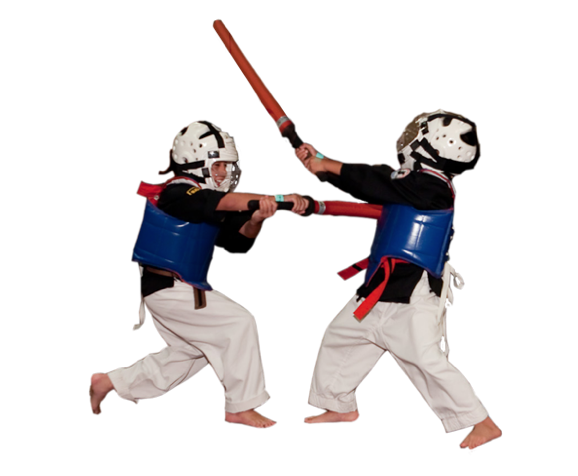Padded Stick Fighting
Required Equipment — Headgear with full face cage, mouthpiece, groin cup, and safety gloves
Optional Equipment – Chest protector, shin pads, footgear which offers full coverage from heel to toe.
(Foam) Weapon’s Contact Rules:
There Is No Age Limit for Weapon Sparring Competitors
Weapons Divisions:
Age: Youth
6-9 Yrs. (Boys & Girls)
10- 13 Yrs. (Boys & Girls)
14 – 17 Yrs. (Boys & Girls)
Adults:
18 Yrs. –Up

Weapon Specifications:
Core: The core part of the weapon should be soft and light wood or synthetic plastic material.
Cushion: The cushion must be of sponge or foam that is light and soft. There should be at least 1/3 in. of free moving space between the core and the cushion all around in order to buffer the shock.
Cover: The cloth cover material made of slippery texture is required to secure the core and the cushion. And, it should not be sandy or rough in texture, so it does not cause any abrasion when it contacts and brushes the bare skin.
Tip: The Tips of the weapons should be cushioned at least 2 inches thick with very soft sponge, not hard foam.
Handle: The Handle does not require any cushion.
The Pommel of the handle: The pommel of the handle (the lowest part of the handle below your grip), must be cushioned at least 1 inch thick.
Guards: The guards for swords or spears must be made of soft rubber, foam, or hard sponge.
Tassel: Not required. If used, only red non-metallic tassels are allowed. If any weight is used on the tassels, only sponge weights are permitted.
Flexibility: All weapons should be somewhat flexible, not rigid.
Breakage: If your weapon breaks during a match, the judge will suspend the fight and the competitor many change the weapon (only the same type, identical weapon).
Damage: If damage of a weapon occurs, both competitors should voluntarily and immediately stop the engagement. Continuing the fight with a damaged weapon will cause disqualification of the fighter/s.
Metal: Absolutely no metal parts allowed in the structure.
Weight: All weapons should be light in weight. If a competitor has a heavier than normally accepted ICWSF/WSF certified weapon, he/she should obtain pre-authorization from the center referee prior to competition to avoid disqualification.
- A short weapon is defined as any weapon up to 48 inches in overall length.
- A long weapon is defined as any weapon longer than 48 inches in overall length.
Acceptance of required equipment is at the sole discretion of the Center Referee and tournament staff.
Time: Running two (2) minutes. Time stopped only at the request of the Center Referee.
If there is no score, or even scores at the end of two minutes, the “Quick Death” method is used to determine the winner within next one minute. Then -judges call after 1 minute.
In the event of “Quick Death,” any gain of points will immediately determine the winner.
Scoring:
* 3 Points Scored for Strikes to the head, torso (front and back) or for disarming a weapon. (loss of weapon).
* 2 Points Scored for Strikes to the arms and or legs.
* 1 Points Scored for Pommel Strike
* Score areas: Side of head, forehead, chest, stomach, back, side areas, arms, and legs.
Winners Options:
OPTION 1 – Time Limited Competition
The winner is the competitor who obtains the highest score in the time allotted.
OPTION 2 – Score Limited Competition
The match will be awarded to the competitor reaching full score first (total of 10 points).
Penalties: (Fouls)
* Attacking with Excessive Force
* Attacking to the No Contact” areas such as eyes, groin, or base of skull.
* No excessive contact or repeated blows once point has been called.
* Two points will be deducted if one loses a weapon. If both fighters lose their weapons, the referee will stop the fight and both fighters will collect their weapons to resume the fight.
* Throwing a weapon is not allowed, and considered voluntary disarming which causes a deduction of two points.
* Each illegal attack will receive a penalty from any one judge, and lose 2 points.
* If the referee determines that a fighter is intentionally avoiding the engagement, he/she will lose 2 points.
* The referee has the right to disqualify a competitor from the bout, if the competitor continued to engage in unsportsmanlike conduct.
* Any disgraceful or improper behavior towards (Referee, Judges or Opponent will receive a warning and lose 2 points. Next offense brings disqualification.
* Three warnings in total within a match will disqualify the fighter.
* Using weapons that are not allowed in the match will disqualify the fighter.
Judging Commands:
* Face me: Bow
* Face each other: Bow (shake hands).
* Ready position.
* Kai-Si. (Begin.)
* Ready judge.
* Score.
Judging Signals:
* Flag raise towards competitor — Point called.
* Judge touches own torso with other flag to indicate 3 points.
* Judge touches own leg with other flag to indicate 2 points.
* Judge points to floor with other flag to indicate 1 point.
* Cross extended arms — Did not see or no point called.
* Pointing to boundary — Out of bounds.
* Fist hitting open hand — Excessive contact observed.
* Fist to ear and point to competitor — Foul called (deduct 1 point).


